The spider silk fibers market is expected to grow from USD 180.3 million in 2025 to USD 1,116.4 million by 2035, at a CAGR of 20.0%. Demand is concentrated in countries with biotech research depth, advanced textiles capability, and strong capital access. The United States remains a major demand center, supported by partnerships between performance apparel brands, defense agencies, and medical device developers. Applications span high-strength yarns for protective gear, lightweight composites, and biomedical threads for sutures or scaffolds. Procurement in the US is anchored by pilot and mid-scale programs prioritizing traceable quality, consistent mechanical properties, and regulatory readiness. Canada shows steady pull through university consortia and niche technical textiles firms.
Japan operates as an innovation and early adoption hub with a focus on high-performance fibers and precision manufacturing. Material start-ups, trading houses, and apparel groups drive limited edition runs in luxury fashion, sportswear, and specialty yarns. South Korea creates similar momentum through technical textiles clusters and conglomerates investing in bio-based materials with clear performance advantages. China offers the largest volume upside due to scale in spinning, weaving, and finishing, along with a fast-moving sportswear and e-commerce ecosystem. Early demand arises from premium categories and defense trials, with adoption linked to cost reductions and domestic recombinant protein production.
Germany emphasizes engineered applications across automotive interiors, lightweight composites, and medical textiles. Procurement is focused on repeatability, certification, and integration into processing lines. France, Italy, and the Nordics contribute selective demand in luxury, outdoor gear, and design-driven collaborations showcasing strength-to-weight advantages. The United Kingdom maintains activity through research, translation, and specialty yarn development for aerospace and healthcare pilots. The Middle East demonstrates project-based demand linked to advanced material initiatives. Brazil in Latin America leads through technical textiles and academic programs, with modest volumes in the forecast horizon.
Innovation trends revolve around protein engineering, bioprocess intensification, and fiber processing advances. Protein engineering focuses on sequence design for tensile strength, beta sheet control, and improved spinning behavior. Bioprocessing targets higher expression titers, low-cost feedstocks, continuous fermentation, and purification methods preserving molecular weight distribution. Fiber processing explores dope rheology, multi-jet wet spinning, post-draw annealing, and surface treatments for abrasion resistance and dye uptake. Blends with nylon or bio-based polyesters are explored for cost efficiency while retaining performance benefits. Standardization of test methods, certification, and lifecycle data reduces procurement risks and supports cross-border approvals. Country-level demand patterns combined with innovation vectors point toward rapid scale-up through 2035, with value creation tied to repeatable performance and integration into textile supply chains.
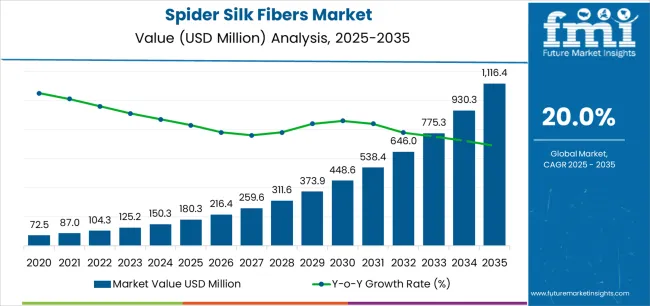
| Period | Primary Revenue Buckets | Share | Notes |
|---|---|---|---|
| Today | Synthetic spider silk products (research, prototyping) | 58% | Laboratory applications, biotechnology research |
| Natural spider silk extractions | 32% | Traditional extraction methods, specialty applications | |
| Material testing services | 7% | Performance validation, quality assessment | |
| Licensing & IP services | 3% | Technology transfer, patent licensing | |
| Future (3-5 yrs) | Commercial synthetic silk systems | 42-45% | Scalable production, industrial manufacturing |
| Biomedical device applications | 22-25% | Surgical sutures, implants, drug delivery | |
| High-performance textile integration | 18-21% | Athletic wear, protective clothing, luxury textiles | |
| Military & defense applications | 8-12% | Bulletproof materials, parachutes, protective gear | |
| Research & development services | 5-8% | Custom formulations, application development | |
| Material science consulting | 3-5% | Technical advisory, performance optimization |
At-a-Glance Metrics
| Metric | Value |
|---|---|
| Market Value (2025) | USD 180.3 million |
| Market Forecast (2035) | USD 1,116.4 million |
| Growth Rate | 20.0% CAGR |
| Leading Technology | Synthetic Spider Silk Systems |
| Primary Application | Biomedical Segment |
The spider silk fibers market demonstrates exceptional fundamentals, with synthetic spider silk systems capturing a dominant share through advanced biotechnology capabilities and material performance optimization. Biomedical applications drive primary demand, supported by increasing surgical requirements and medical device innovation. Geographic expansion remains concentrated in developed markets with established biotechnology infrastructure, while emerging economies show accelerating adoption rates driven by research modernization initiatives and rising technology standards.
Primary Classification: The spider silk fibers market segments by product type into synthetic spider silk, natural spider silk, and engineered variants, representing the evolution from laboratory-scale materials to commercial-grade fiber solutions for comprehensive biotechnology applications.
Secondary Classification: Application segmentation divides the spider silk fibers market into biomedical, clothing, material science, military, and specialized applications, reflecting distinct requirements for performance characteristics, biocompatibility standards, and commercial viability.
Tertiary Classification: End-use segmentation covers research institutions, textile manufacturers, medical device companies, defense contractors, and biotechnology firms, while distribution channels span direct sales, specialized distributors, and research partnerships.
Regional Classification: Geographic distribution covers North America, Latin America, Western Europe, Eastern Europe, East Asia, South Asia Pacific, and Middle East & Africa, with developed markets leading adoption while emerging economies show accelerating growth patterns driven by biotechnology infrastructure expansion programs.
The segmentation structure reveals technology progression from laboratory-scale materials toward commercial fiber systems with enhanced scalability and performance capabilities, while application diversity spans from research facilities to commercial manufacturing operations requiring precise material solutions.
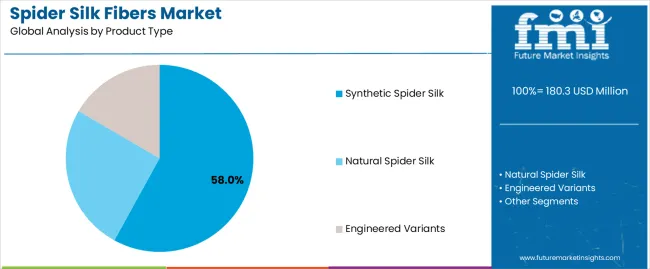
Market Position: Synthetic spider silk systems command the leading position in the spider silk fibers market with 58% market share through advanced biotechnology features, including superior scalability, consistency characteristics, and commercial application optimization that enable manufacturers to achieve optimal material performance across diverse industrial and research environments.
Value Drivers: The segment benefits from manufacturing preference for scalable production systems that provide consistent fiber properties, reduced production complexity, and operational efficiency optimization without requiring significant infrastructure modifications. Advanced biotechnology features enable automated production control systems, quality monitoring, and integration with existing manufacturing equipment, where material performance and production reliability represent critical facility requirements.
Competitive Advantages: Synthetic Spider Silk systems differentiate through proven production scalability, consistent fiber characteristics, and integration with automated manufacturing systems that enhance facility effectiveness while maintaining optimal quality standards suitable for diverse commercial and research applications.
Key market characteristics:
Natural spider silk systems maintain a 32% market position in the spider silk fibers market due to their unique biological properties and performance advantages. These materials appeal to facilities requiring premium fiber solutions with superior mechanical properties for specialized research applications. Market growth is driven by biotechnology research expansion, emphasizing biological material solutions and operational effectiveness through optimized natural designs.
Material Testing Services capture 7% market share through specialized applications in research validation, quality assessment, and performance characterization. These facilities demand comprehensive testing systems capable of handling demanding analysis while providing effective characterization capabilities and operational reliability.
Licensing & IP Services account for 3% market share through technology transfer requirements in specialized biotechnology applications, research facilities, and development operations requiring intellectual property access for specific commercial outcomes.
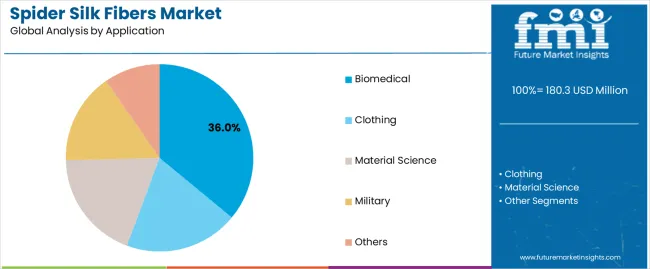
Market Context: Biomedical applications demonstrate the highest growth rate in the spider silk fibers market with 22.1% CAGR and 36% market share due to widespread adoption of biocompatible materials and increasing focus on medical device innovation, operational safety efficiency, and patient outcome applications that maximize therapeutic effectiveness while maintaining biocompatibility standards.
Appeal Factors: Medical device operators prioritize material biocompatibility, performance consistency, and integration with existing healthcare infrastructure that enables coordinated device operations across multiple medical applications. The segment benefits from substantial healthcare investment and modernization programs that emphasize the acquisition of advanced biomaterial systems for device optimization and patient care applications.
Growth Drivers: Healthcare expansion programs incorporate spider silk materials as standard components for medical device operations, while aging population growth increases demand for biocompatible capabilities that comply with regulatory standards and minimize device complexity.
Market Challenges: Varying regulatory requirements and approval complexity may limit material standardization across different medical applications or device scenarios.
Application dynamics include:
Clothing applications capture 28% market share through specialized textile requirements in fashion, athletic wear, and luxury applications. These facilities demand high-performance fiber systems capable of supporting advanced textile properties while providing effective performance access and operational reliability capabilities.
Material Science applications account for 22% market share, including research institutions, testing operations, and academic facilities requiring advanced fiber capabilities for research optimization and performance analysis.
Military applications represent 18% market share through specialized defense requirements in protective equipment, tactical gear, and strategic applications. These facilities demand high-performance materials capable of extreme conditions while providing reliable protection capabilities.
Market Context: Research Institutions dominate the spider silk fibers market with a 21.2% CAGR, reflecting the primary demand source for spider silk fiber technology in biotechnology research and material development operations.
Business Model Advantages: Research Institutions provide direct market demand for advanced fiber materials, driving product innovation and capacity expansion while maintaining quality control and research compliance requirements.
Operational Benefits: Research applications include material characterization, biotechnology development, and quality assurance that drive consistent demand for fiber products while providing access to latest biotechnology advances.
| Category | Factor | Impact | Why It Matters |
|---|---|---|---|
| Driver | Biotechnology advancement & material innovation (synthetic biology, protein engineering) | ★★★★★ | Growing biotechnology capabilities enable scalable spider silk production with enhanced properties for commercial applications across multiple industries. |
| Driver | Medical device industry expansion & biocompatibility demand (surgical applications, implants) | ★★★★★ | Turns advanced biomaterials from "experimental" to "essential"; providers that offer clinical validation and regulatory support gain competitive advantage. |
| Driver | High-performance textile demand & athletic wear growth (sports, luxury fashion) | ★★★★☆ | Athletic and luxury brands need superior performance fibers; demand for lightweight, strong, and comfortable materials expanding addressable market. |
| Restraint | Production scalability & cost challenges (especially for natural extraction methods) | ★★★★☆ | Smaller manufacturers defer investments; increases price sensitivity and slows advanced material adoption in cost-conscious markets. |
| Restraint | Regulatory approval complexity (FDA, medical device regulations) | ★★★☆☆ | Lengthy approval processes for medical applications potentially limiting biomedical material adoption in regulated markets. |
| Trend | Smart textile integration & performance monitoring (wearable technology, sensors) | ★★★★★ | Real-time performance monitoring, wear tracking, and material analytics transform applications; connectivity and digital integration become core value propositions. |
| Trend | Circular economy & bio-based materials (renewable production, biodegradable alternatives) | ★★★★☆ | Bio-based spider silk production for environmental applications; specialized materials and renewable capabilities drive competition toward eco-friendly solutions. |
The spider silk fibers market demonstrates varied regional dynamics with Growth Leaders including China (27.0% growth rate) and India (25.0% growth rate) driving expansion through biotechnology modernization initiatives and research capacity development. Advanced Performers encompass Germany (23.0% growth rate), Brazil (21.0% growth rate), and developed regions, benefiting from established biotechnology industries and advanced material adoption. Mature Markets feature United States (19.0% growth rate), United Kingdom (17.0% growth rate), and Japan (15.0% growth rate), where biotechnology advancement and regulatory standardization requirements support strong growth patterns.
Regional synthesis reveals East Asian markets leading adoption through biotechnology expansion and infrastructure development, while North American countries maintain robust expansion supported by material science advancement and commercial standardization requirements. European markets show strong growth driven by biotechnology applications and innovation integration trends.
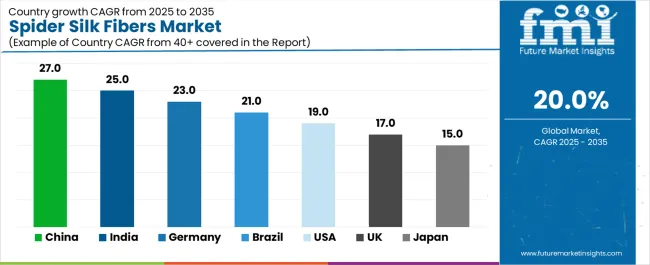
| Region/Country | 2025 to 2035 Growth | How to win | What to watch out |
|---|---|---|---|
| China | 27.0% | Focus on biotechnology modernization solutions | Regulatory changes; local competition |
| India | 25.0% | Lead with cost-effective research systems | Import restrictions; infrastructure limitations |
| Germany | 23.0% | Provide premium biotechnology products | Over-regulation; lengthy approvals |
| Brazil | 21.0% | Offer research-oriented models | Currency fluctuations; import duties |
| United States | 19.0% | Push commercial integration | FDA compliance costs; market competition |
| United Kingdom | 17.0% | Focus on research compatibility | Brexit impacts; funding constraints |
| Japan | 15.0% | Emphasize precision systems | Technology transition; adoption rates |
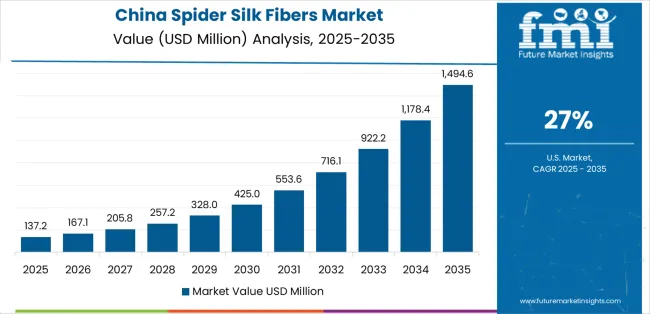
China establishes fastest market growth through aggressive biotechnology modernization programs and comprehensive research capacity development, integrating advanced spider silk fiber systems as standard components in research facilities and biotechnology installations. The country's 27.0% growth rate reflects government initiatives promoting biotechnology infrastructure and domestic material capabilities that mandate the use of advanced fiber systems in research and manufacturing facilities. Growth concentrates in major biotechnology hubs, including Beijing, Shanghai, and Shenzhen, where material science development showcases integrated fiber systems that appeal to research operators seeking advanced material optimization capabilities and commercial applications.
Chinese manufacturers are developing cost-effective spider silk solutions that combine domestic production advantages with advanced biotechnology features, including automated production control and enhanced quality capabilities. Distribution channels through research equipment suppliers and biotechnology service distributors expand market access, while government support for biotechnology modernization supports adoption across diverse research and commercial segments.
Strategic Market Indicators:
In Delhi, Mumbai, and Bangalore, research facilities and biotechnology centers are implementing advanced spider silk fiber systems as standard equipment for material research and commercial applications, driven by increasing government biotechnology investment and infrastructure modernization programs that emphasize the importance of advanced material capabilities. The spider silk fibers market holds a 25.0% growth rate, supported by government biotechnology initiatives and infrastructure development programs that promote advanced fiber systems for research and manufacturing facilities. Indian operators are adopting spider silk systems that provide consistent material performance and quality features, particularly appealing in urban regions where research effectiveness and commercial outcomes represent critical operational requirements.
Market expansion benefits from growing biotechnology capabilities and international technology partnerships that enable domestic production of advanced fiber systems for research and commercial applications. Technology adoption follows patterns established in biotechnology equipment, where reliability and performance drive procurement decisions and operational deployment.
Market Intelligence Brief:
Germany's advanced biotechnology market demonstrates sophisticated spider silk fiber deployment with documented research effectiveness in material applications and biotechnology facilities through integration with existing research systems and biotechnology infrastructure. The country leverages engineering expertise in biotechnology and quality systems integration to maintain a 23.0% growth rate. Research centers, including Baden-Württemberg, Bavaria, and North Rhine-Westphalia, showcase premium installations where fiber systems integrate with comprehensive research platforms and facility management systems to optimize material operations and research effectiveness.
German manufacturers prioritize system precision and EU compliance in biotechnology equipment development, creating demand for premium systems with advanced features, including facility monitoring integration and automated quality systems. The spider silk fibers market benefits from established biotechnology infrastructure and a willingness to invest in advanced material technologies that provide long-term operational benefits and compliance with international biotechnology standards.
Market Intelligence Brief:
Brazil's market expansion benefits from diverse research demand, including infrastructure modernization in São Paulo and Rio de Janeiro, biotechnology facility upgrades, and government research programs that increasingly incorporate fiber solutions for material applications. The country maintains a 21.0% growth rate, driven by rising biotechnology activity and increasing recognition of advanced material benefits, including precise performance control and enhanced research effectiveness.
Market dynamics focus on cost-effective fiber solutions that balance advanced research performance with affordability considerations important to Brazilian biotechnology operators. Growing biotechnology industrialization creates continued demand for modern fiber systems in new facility infrastructure and research modernization projects.
Strategic Market Considerations:
United States establishes market leadership through comprehensive biotechnology programs and advanced research infrastructure development, integrating spider silk fiber systems across university and commercial applications. The country's 19.0% growth rate reflects established biotechnology industry relationships and mature material technology adoption that supports widespread use of precision fiber systems in research and manufacturing facilities. Growth concentrates in major biotechnology centers, including California, Massachusetts, and North Carolina, where material science showcases mature fiber deployment that appeals to research operators seeking proven material capabilities and operational efficiency applications.
American biotechnology providers leverage established distribution networks and comprehensive technical support capabilities, including validation programs and training support that create customer relationships and operational advantages. The spider silk fibers market benefits from mature regulatory standards and biotechnology requirements that mandate fiber system use while supporting technology advancement and operational optimization.
Market Intelligence Brief:
United Kingdom's biotechnology market demonstrates integrated spider silk fiber deployment with documented research effectiveness in university applications and commercial biotechnology facilities through integration with existing research systems and biotechnology infrastructure. The country maintains a 17.0% growth rate, supported by biotechnology modernization programs and research effectiveness requirements that promote advanced fiber systems for material applications. Research facilities across England, Scotland, and Wales showcase systematic installations where fiber systems integrate with comprehensive research platforms to optimize material operations and research outcomes.
UK biotechnology providers prioritize system reliability and research compatibility in material equipment procurement, creating demand for validated systems with proven research features, including data monitoring integration and automated quality systems. The spider silk fibers market benefits from established biotechnology infrastructure and research validation requirements that support material technology adoption and operational effectiveness.
Market Intelligence Brief:
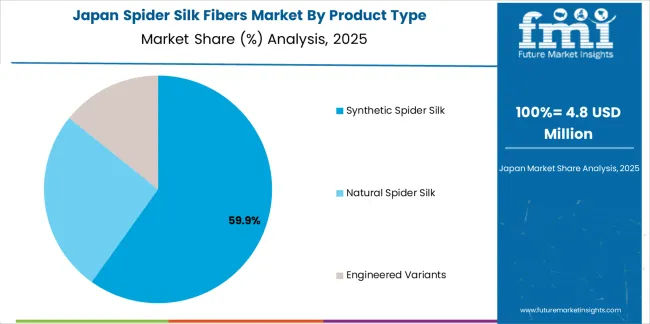
Japan's market growth benefits from precision biotechnology demand, including advanced research facilities in Tokyo and Osaka, biotechnology integration, and innovation programs that increasingly incorporate fiber solutions for material applications. The country maintains a 15.0% growth rate, driven by biotechnology advancement and increasing recognition of precision material benefits, including accurate performance control and enhanced research outcomes.
Market dynamics focus on high-precision fiber solutions that meet Japanese quality standards and research effectiveness requirements important to biotechnology operators. Advanced biotechnology adoption creates continued demand for sophisticated fiber systems in research facility infrastructure and biotechnology modernization projects.
Strategic Market Considerations:
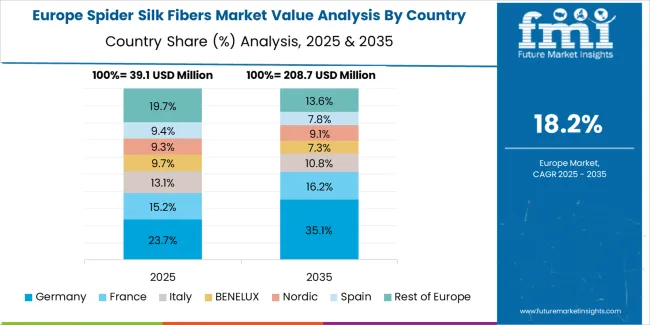
The European spider silk fibers market is projected to grow from USD 42.1 million in 2025 to USD 259.8 million by 2035, registering a CAGR of 20.1% over the forecast period. Germany is expected to maintain its leadership position with a 34.5% market share in 2025, supported by its advanced biotechnology infrastructure and major research centers.
United Kingdom follows with a 26.8% share in 2025, driven by comprehensive research programs and biotechnology development initiatives. France holds a 18.2% share through specialized material applications and research compliance requirements. Italy commands a 12.1% share, while Spain accounts for 8.4% in 2025. The rest of Europe region is anticipated to gain momentum, expanding its collective share from 6.7% to 7.2% by 2035, attributed to increasing biotechnology adoption in Nordic countries and emerging research facilities implementing biotechnology modernization programs.
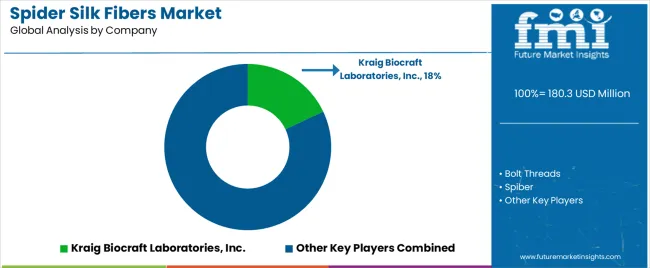
| Stakeholder | What they actually control | Typical strengths | Typical blind spots |
|---|---|---|---|
| Global platforms | Distribution reach, broad product portfolios, research networks | Wide availability, proven technology, multi-region support | Product development cycles; customer dependency on research validation |
| Biotechnology innovators | R&D capabilities; advanced fiber production; clean scalability profiles | Latest technologies first; attractive ROI on material performance | Service density outside core regions; customization complexity |
| Regional specialists | Local compliance, fast delivery, nearby technical support | "Close to site" support; pragmatic pricing; local regulations | Technology gaps; talent retention in technical support |
| Research-focused ecosystems | Material validation, application development, regulatory support | Lowest technical risk; comprehensive support | Service costs if overpromised; technology obsolescence |
| Niche specialists | Specialized applications, custom materials, research support | Win development applications; flexible configurations | Scalability limitations; narrow market focus |
| Item | Value |
|---|---|
| Quantitative Units | USD 180.3 million |
| Product Type | Synthetic Spider Silk, Natural Spider Silk, Engineered Variants |
| Application | Biomedical, Clothing, Material Science, Military, Others |
| End Use | Research Institutions, Textile Manufacturers, Medical Device Companies, Defense Contractors, Biotechnology Firms |
| Regions Covered | North America, Latin America, Western Europe, Eastern Europe, East Asia, South Asia Pacific, Middle East & Africa |
| Countries Covered | China, India, Germany, Brazil, United States, United Kingdom, Japan, Canada, France, Australia, and 25+ additional countries |
| Key Companies Profiled | Kraig Biocraft Laboratories Inc., Bolt Threads, Spiber, Spintex Engineering, AMSilk, Inspidere, Nexia Biotechnologies Inc., Protein Evolution Inc. |
| Additional Attributes | Dollar sales by product type and application categories, regional adoption trends across East Asia, North America, and Western Europe, competitive landscape with biotechnology manufacturers and material suppliers, research operator preferences for material performance and scalability reliability, integration with biotechnology platforms and production systems, innovations in fiber production and material enhancement, and development of advanced fiber solutions with enhanced performance and commercial optimization capabilities. |
The global spider silk fibers market is estimated to be valued at USD 180.3 million in 2025.
The market size for the spider silk fibers market is projected to reach USD 1,116.4 million by 2035.
The spider silk fibers market is expected to grow at a 20.0% CAGR between 2025 and 2035.
The key product types in spider silk fibers market are synthetic spider silk , natural spider silk and engineered variants.
In terms of application, biomedical segment to command 36.0% share in the spider silk fibers market in 2025.






Full Research Suite comprises of:
Market outlook & trends analysis
Interviews & case studies
Strategic recommendations
Vendor profiles & capabilities analysis
5-year forecasts
8 regions and 60+ country-level data splits
Market segment data splits
12 months of continuous data updates
DELIVERED AS:
PDF EXCEL ONLINE
Spider Lift Market Size and Share Forecast Outlook 2025 to 2035
Spider Cranes Market Analysis based on Lifting Capacity, Operation, Control System, Application, Ownership and Region: A Forecast from 2025 to 2035
Spider Silk Fabric Market Size and Share Forecast Outlook 2025 to 2035
Synthetic Spider Silk Proteins Market Analysis - Size, Share, and Forecast Outlook 2025 to 2035
Silky Matte Film Market Size and Share Forecast Outlook 2025 to 2035
Silk Laminated Paper Market Analysis - Size, Share, and Forecast Outlook 2025 to 2035
Silk Protein Market Analysis - Sericin & Fibroin Forecast 2024-2034
Silk Market Growth – Trends & Forecast 2024-2034
Mimetic Silk Protein Formulas Market Size and Share Forecast Outlook 2025 to 2035
Hydrolyzed Silk Proteins Market Analysis - Size, Share, and Forecast Outlook 2025 to 2035
Nano Fibers Market Size and Share Forecast Outlook 2025 to 2035
Citrus Fiber Market Trends - Functional Applications & Growth 2025 to 2035
Blended Fibers Market Size and Share Forecast Outlook 2025 to 2035
Clothing Fibers Market Size and Share Forecast Outlook 2025 to 2035
Polyimide Fibers Market Analysis - Size, Share, and Forecast Outlook 2025 to 2035
Food Dietary Fibers Market Size and Share Forecast Outlook 2025 to 2035
High-Performance Fibers for Defense Market Report – Demand, Trends & Industry Forecast 2025 to 2035
Drug Integrated Polymer Fibers Market Size and Share Forecast Outlook 2025 to 2035
Cellulose Nanocrystals and Nanofibers Market Size and Share Forecast Outlook 2025 to 2035
Thermal Insulation Materials for Optical Fibers Market Size and Share Forecast Outlook 2025 to 2035

Thank you!
You will receive an email from our Business Development Manager. Please be sure to check your SPAM/JUNK folder too.
Chat With
MaRIA